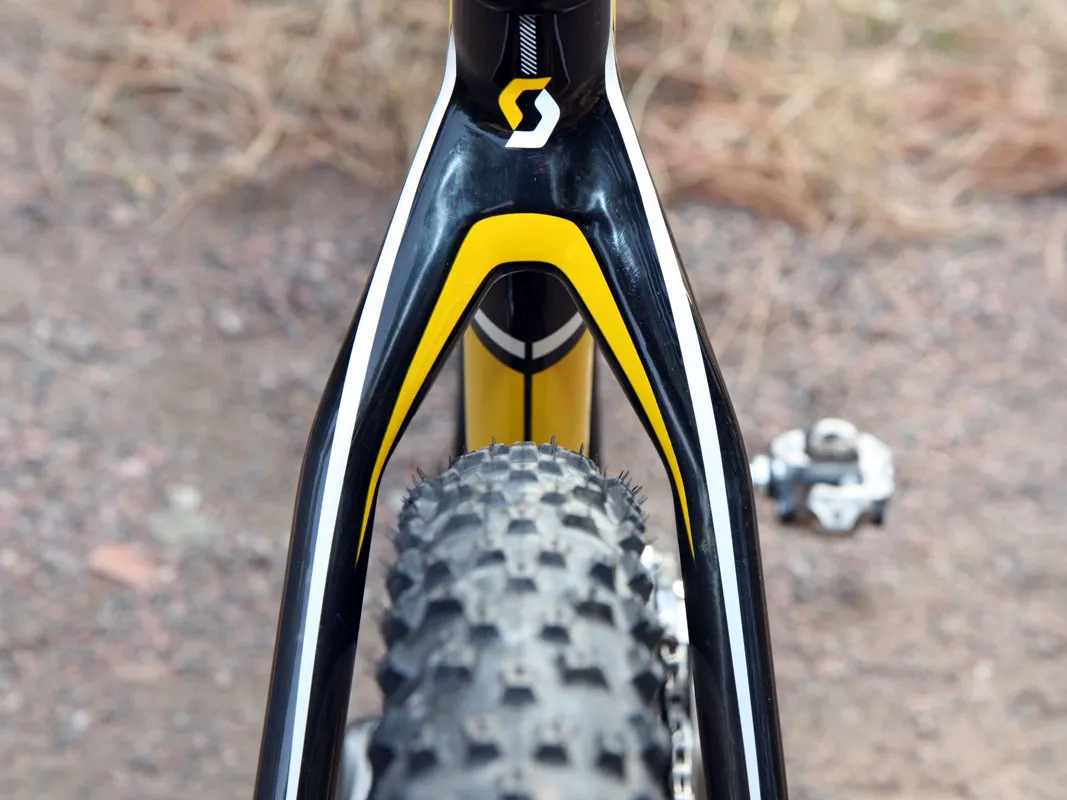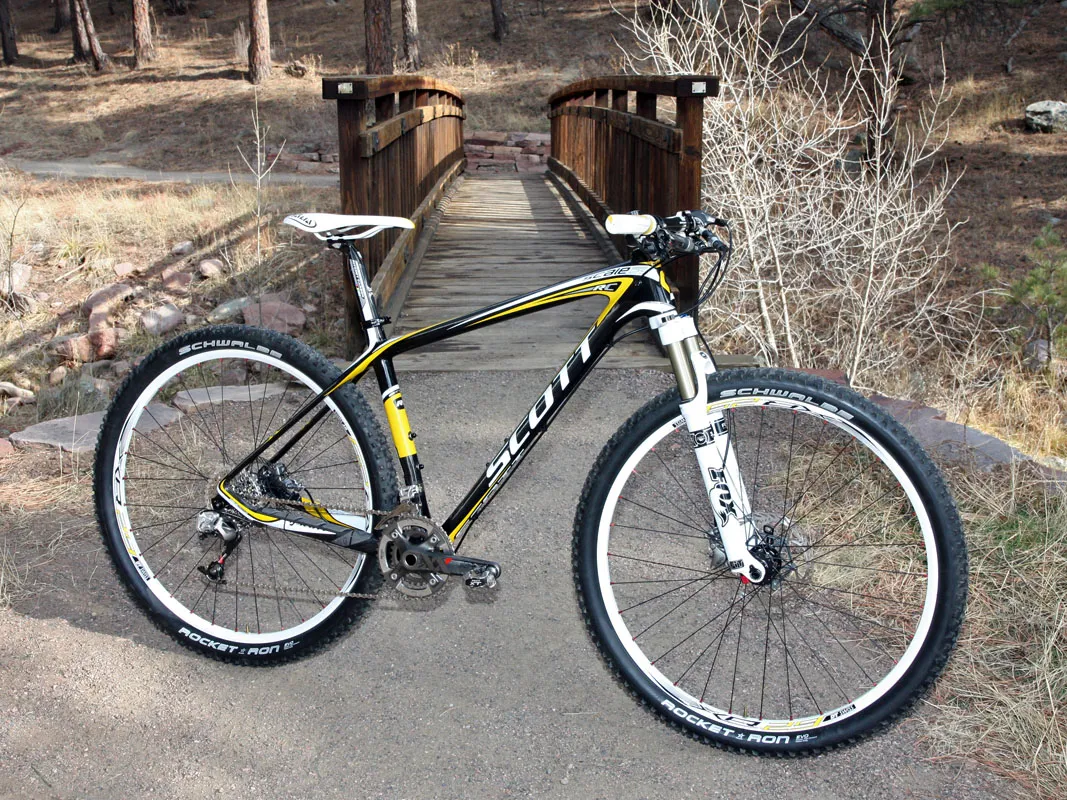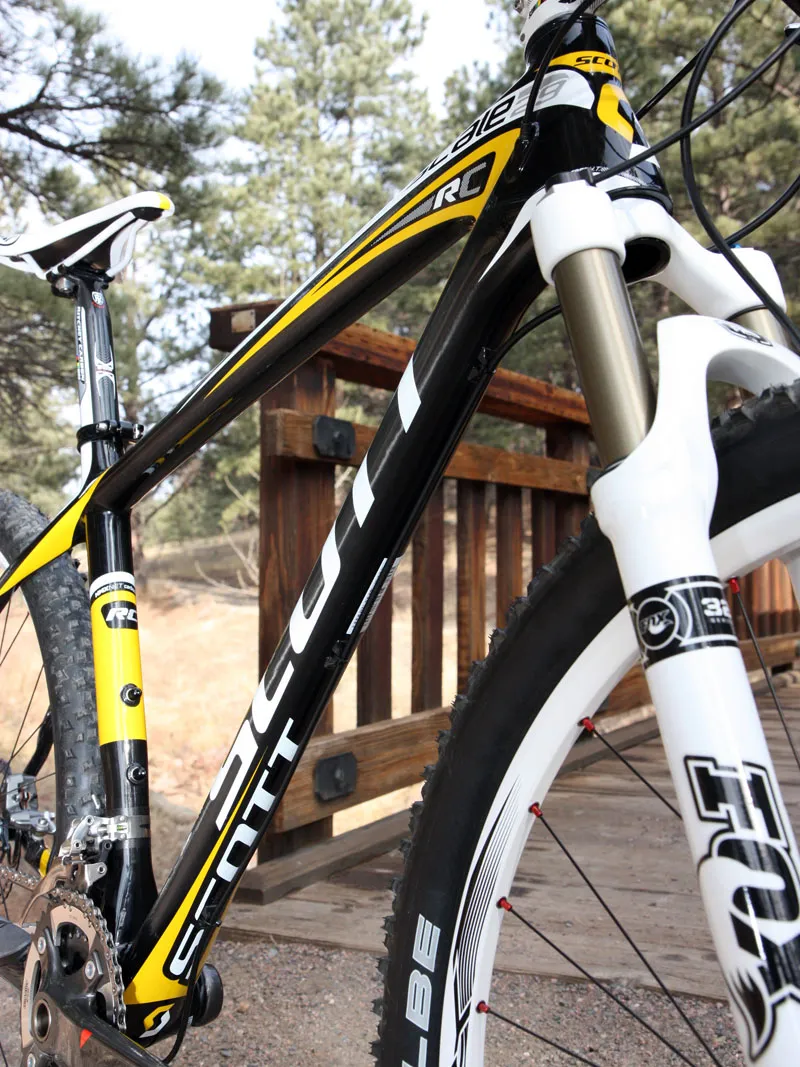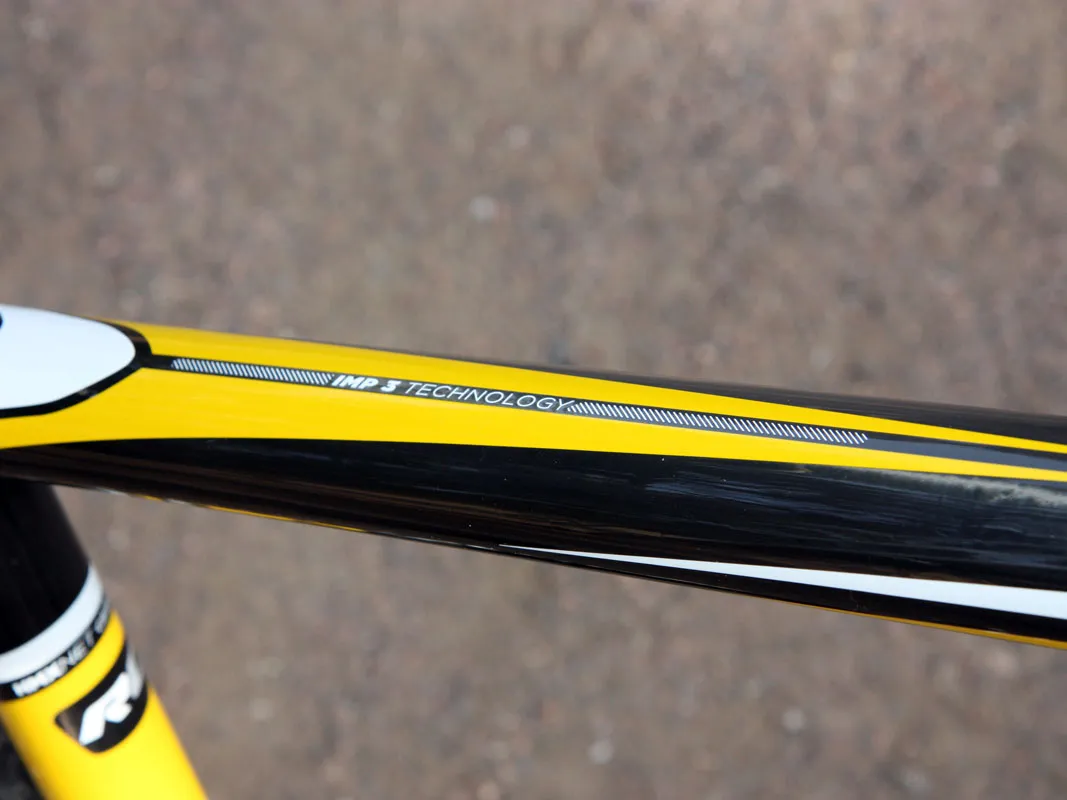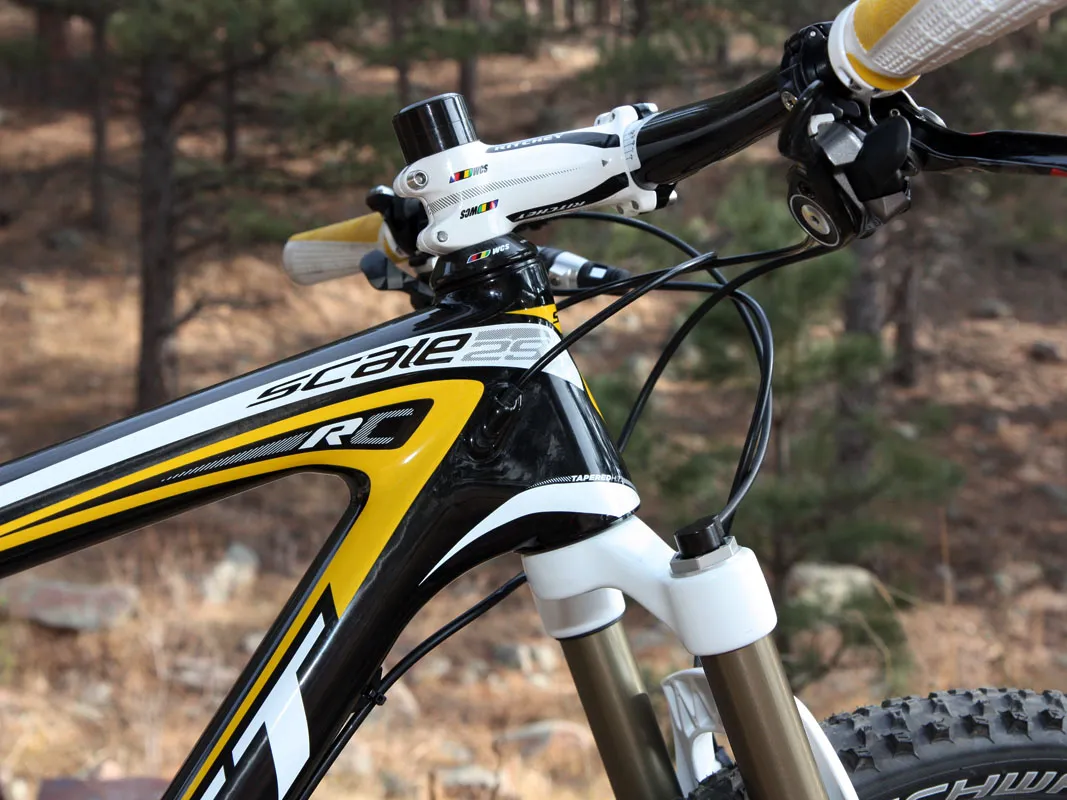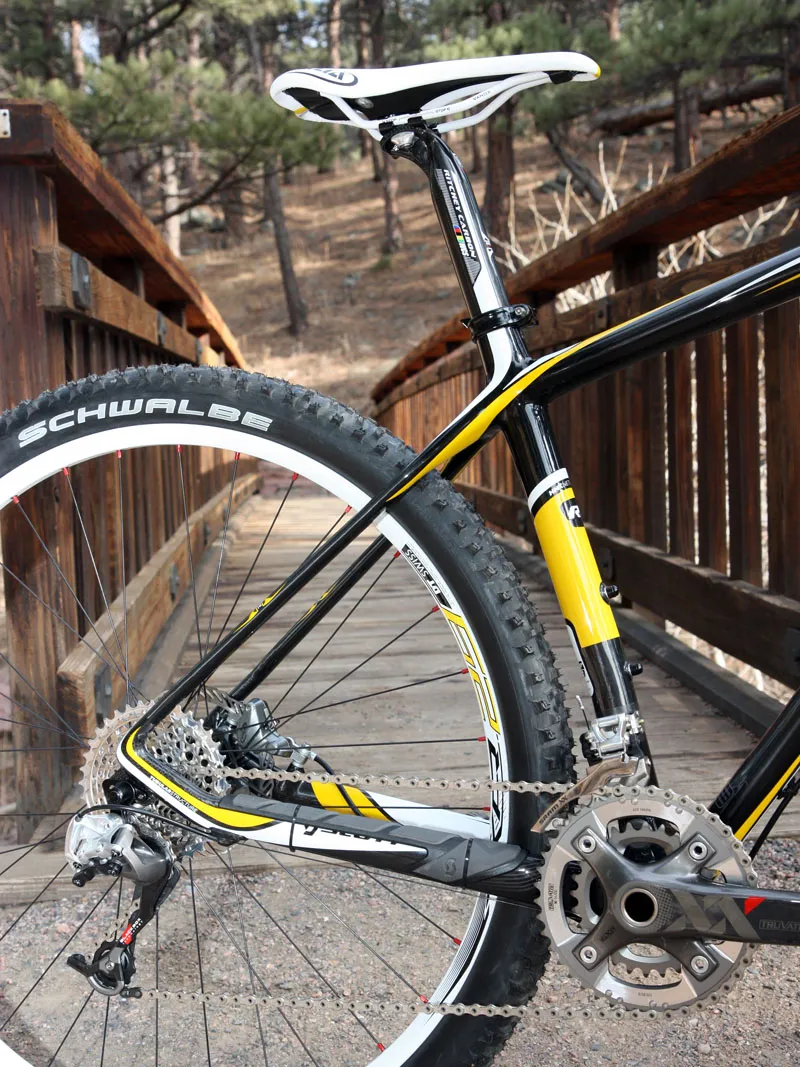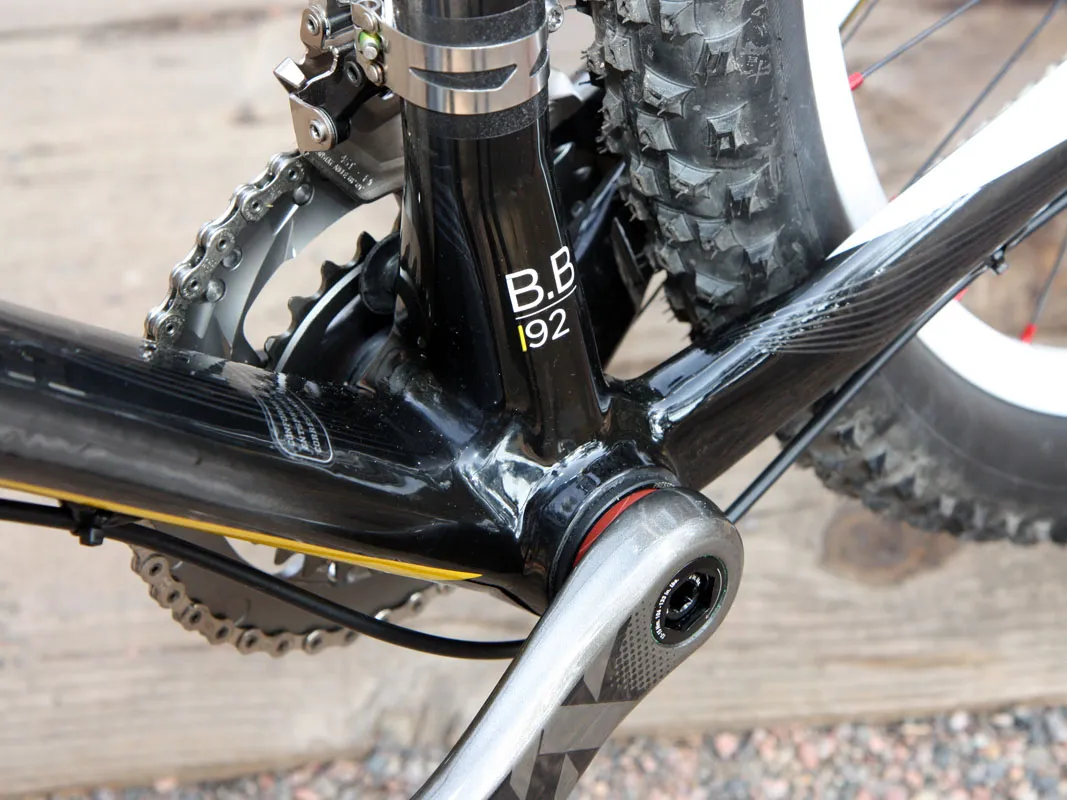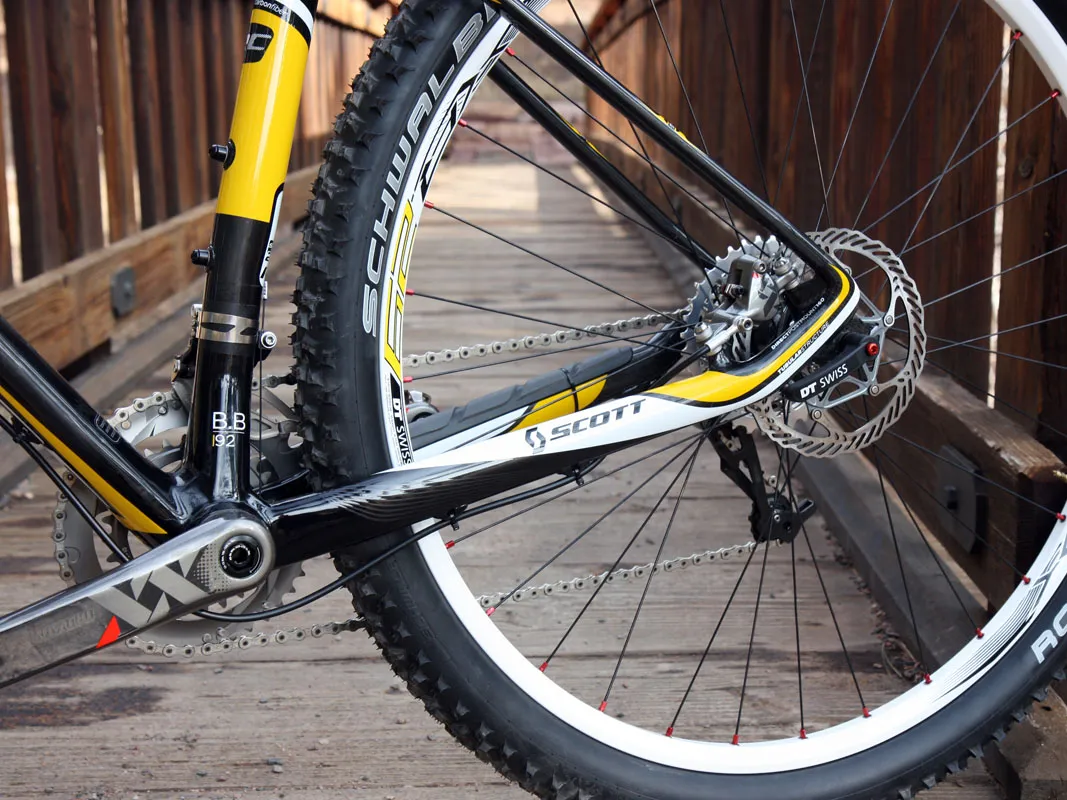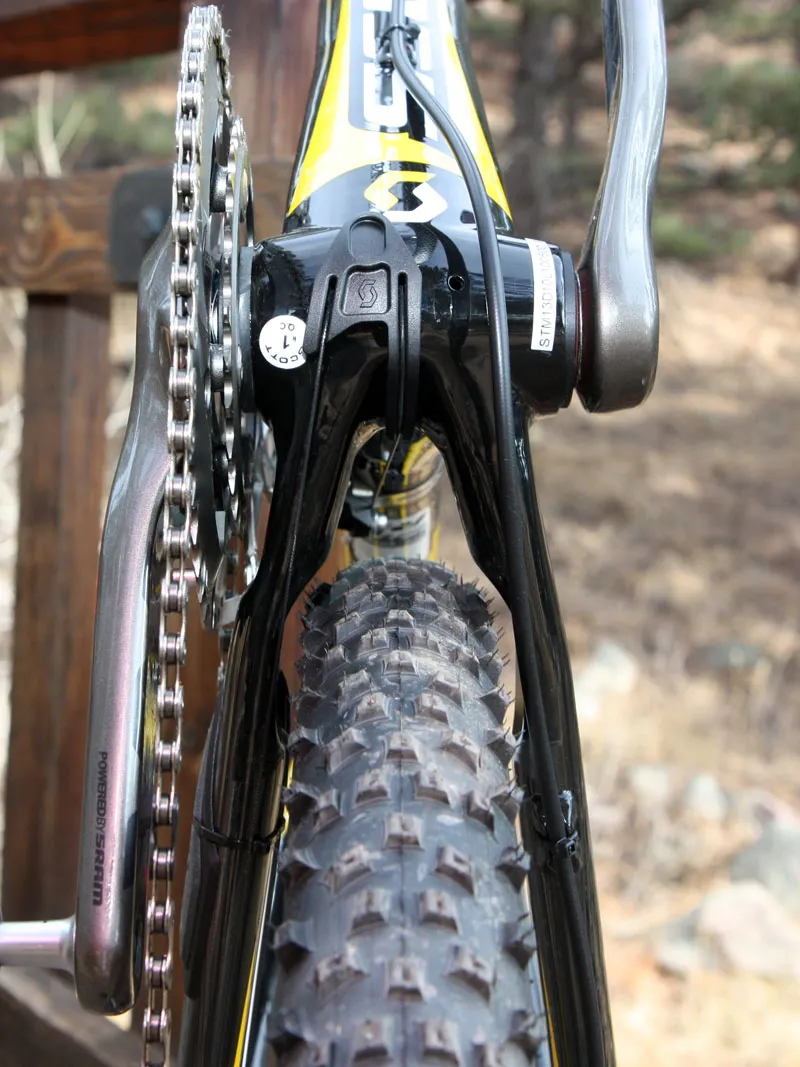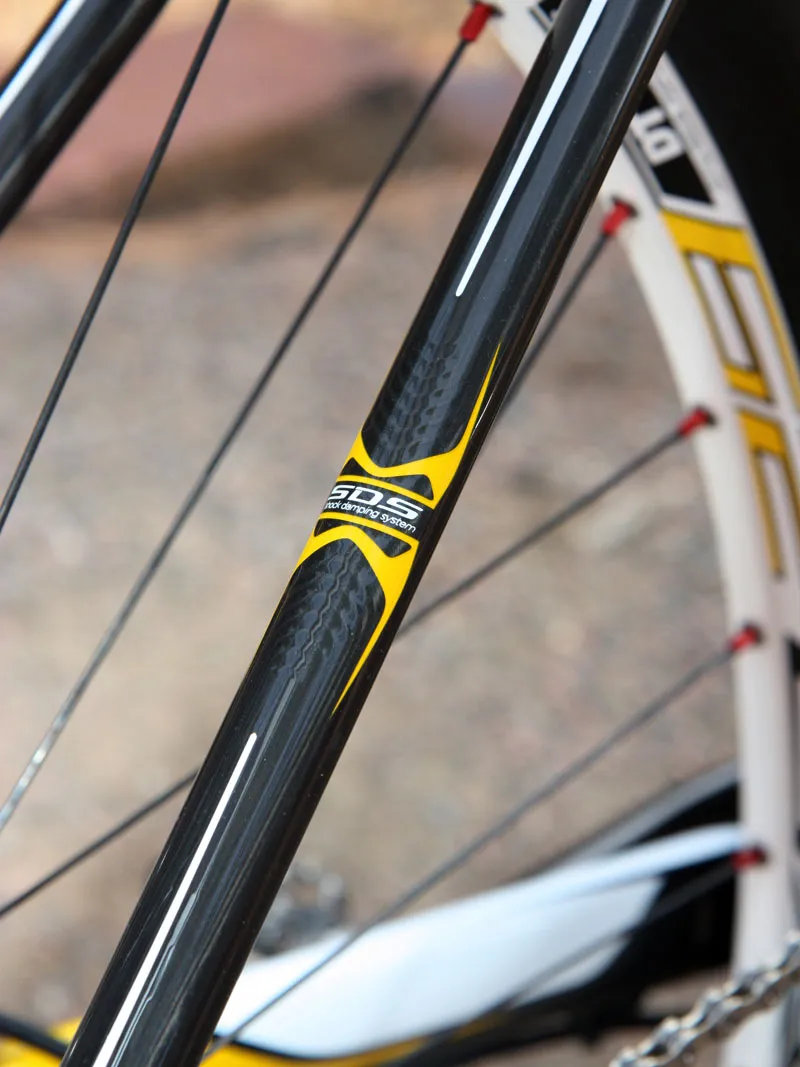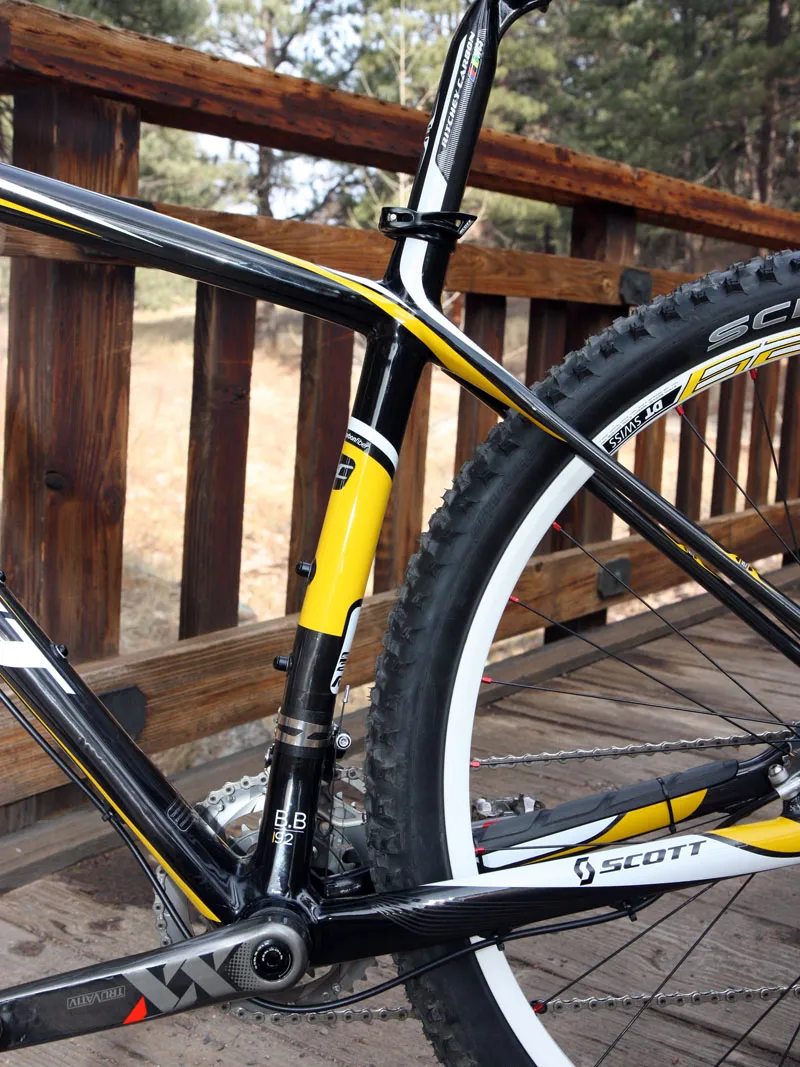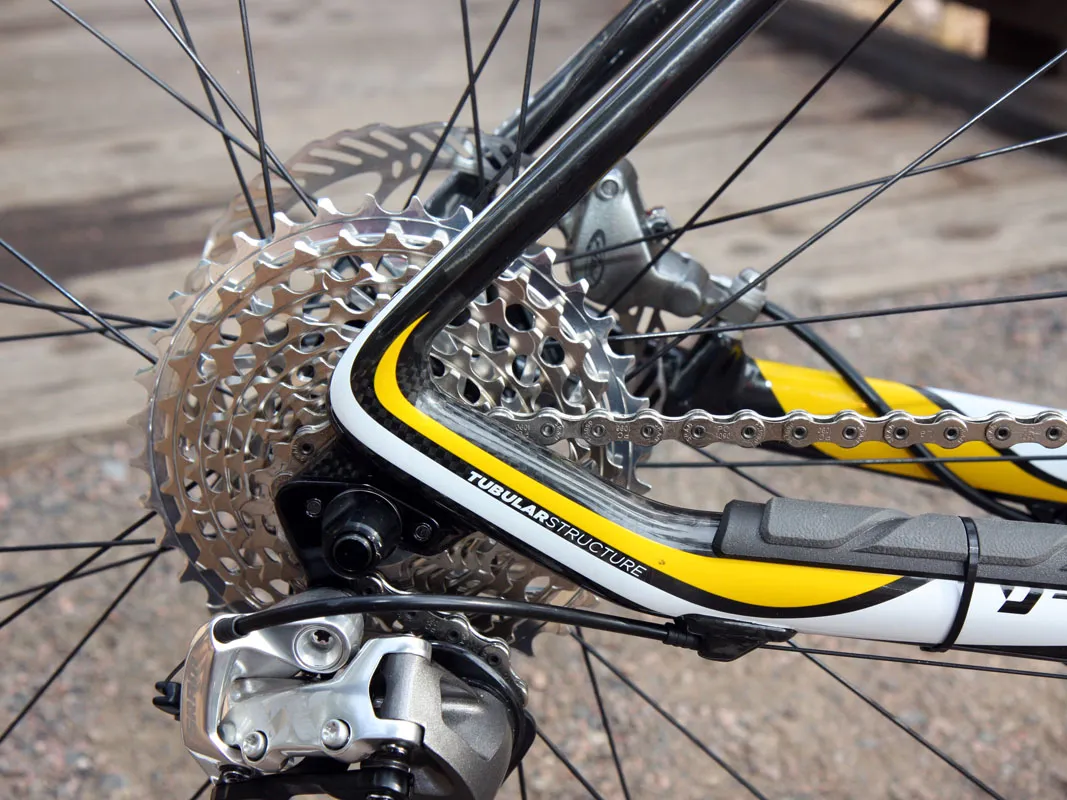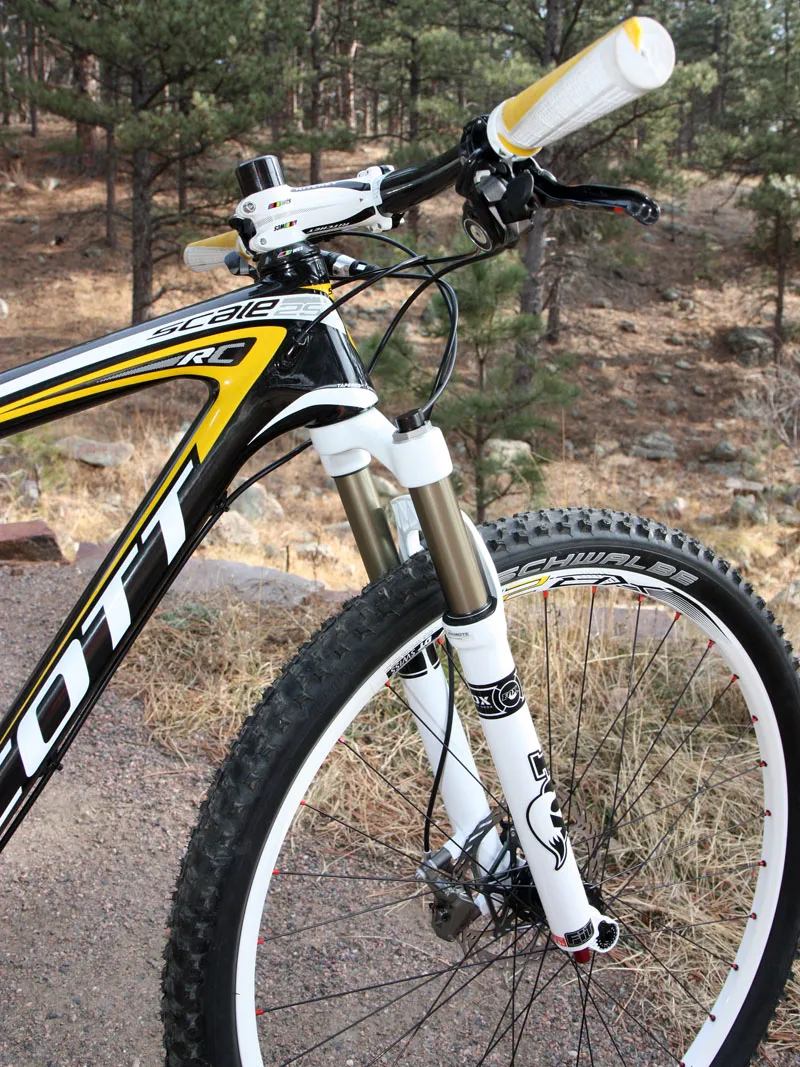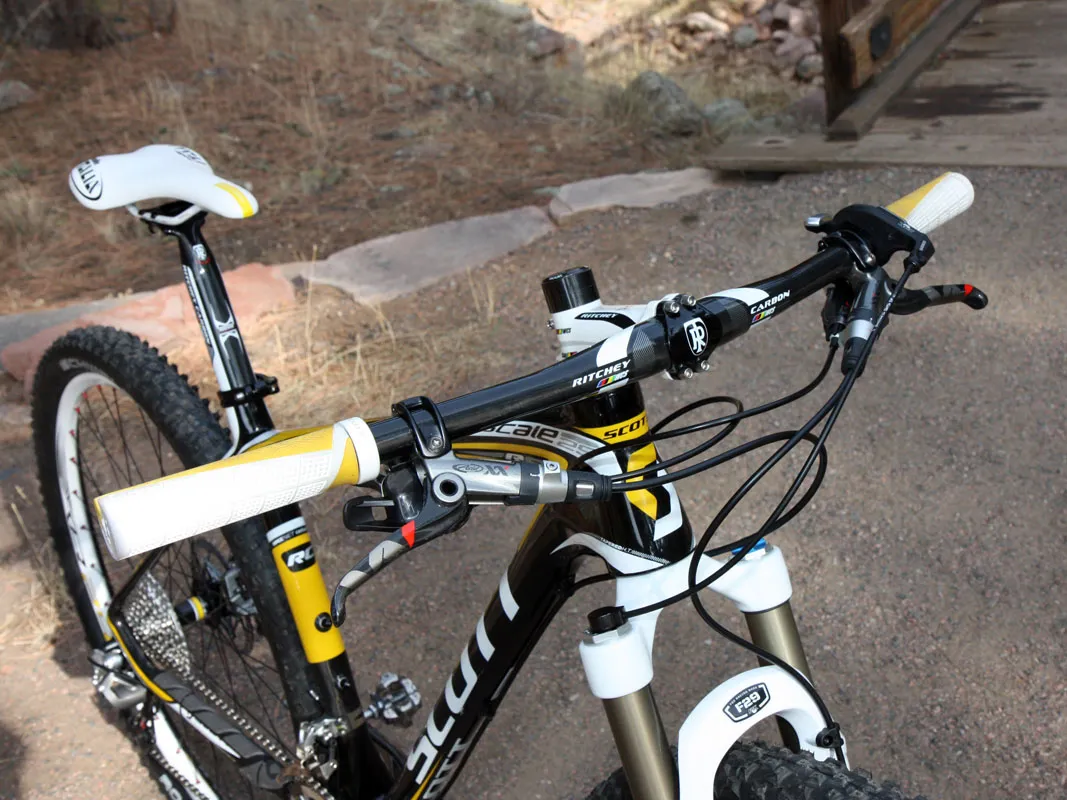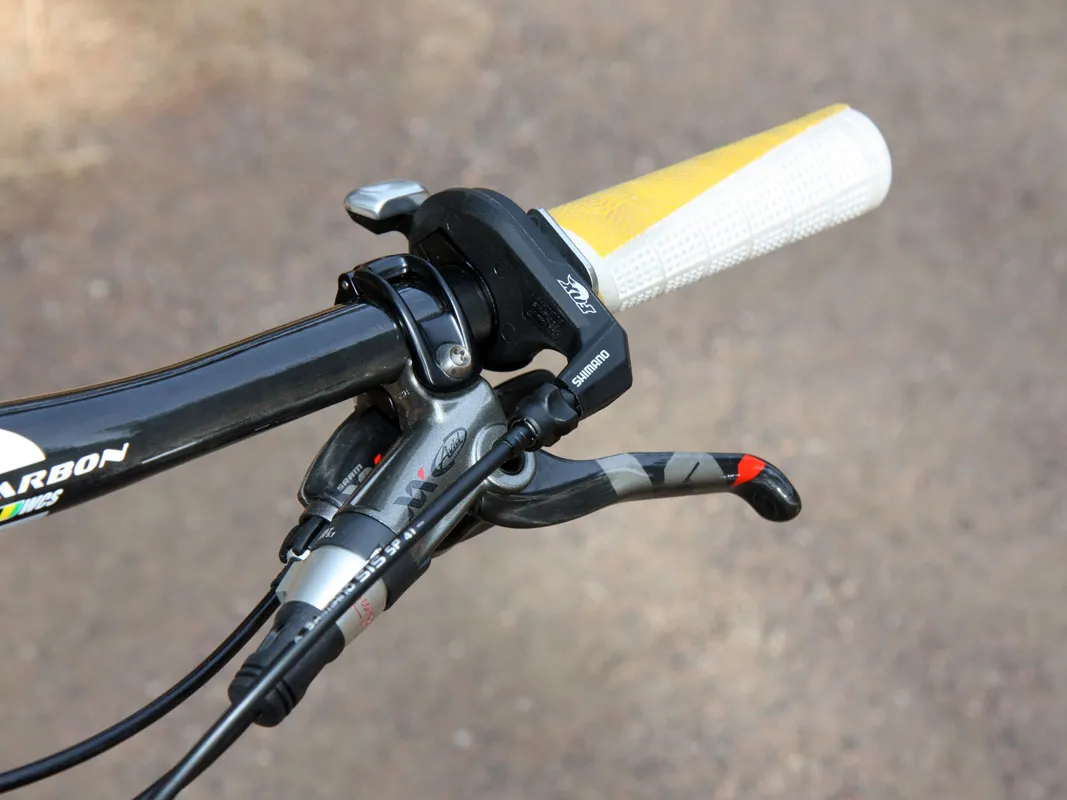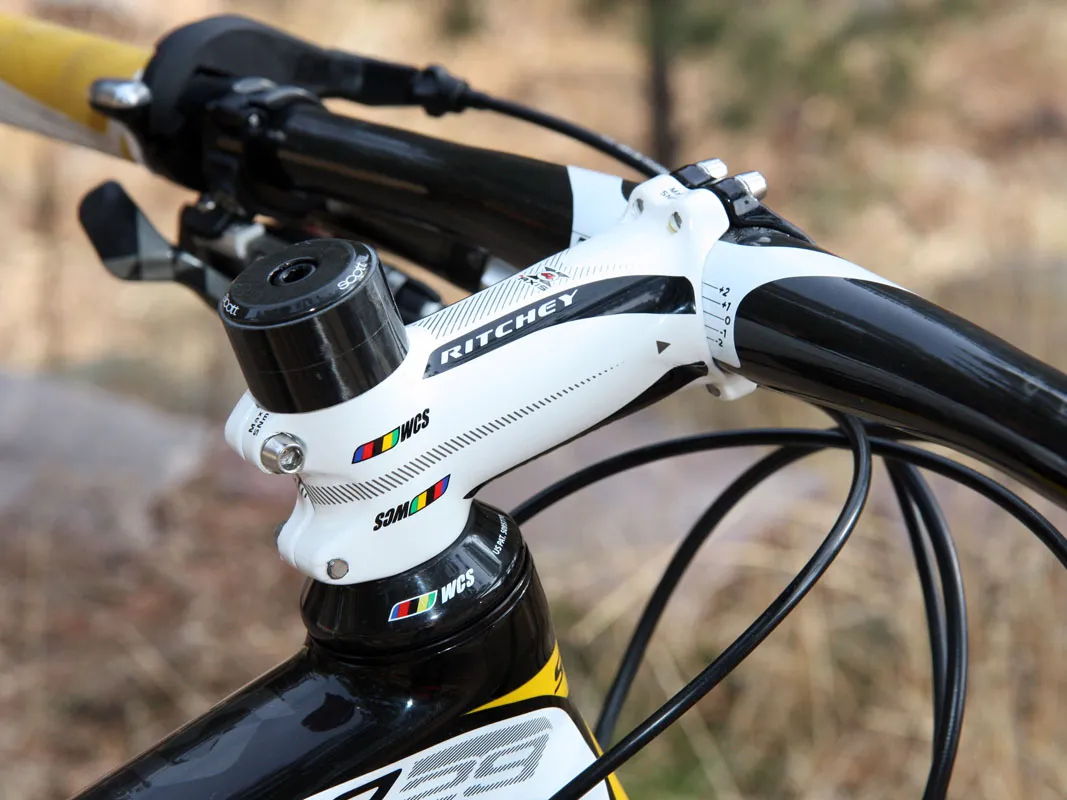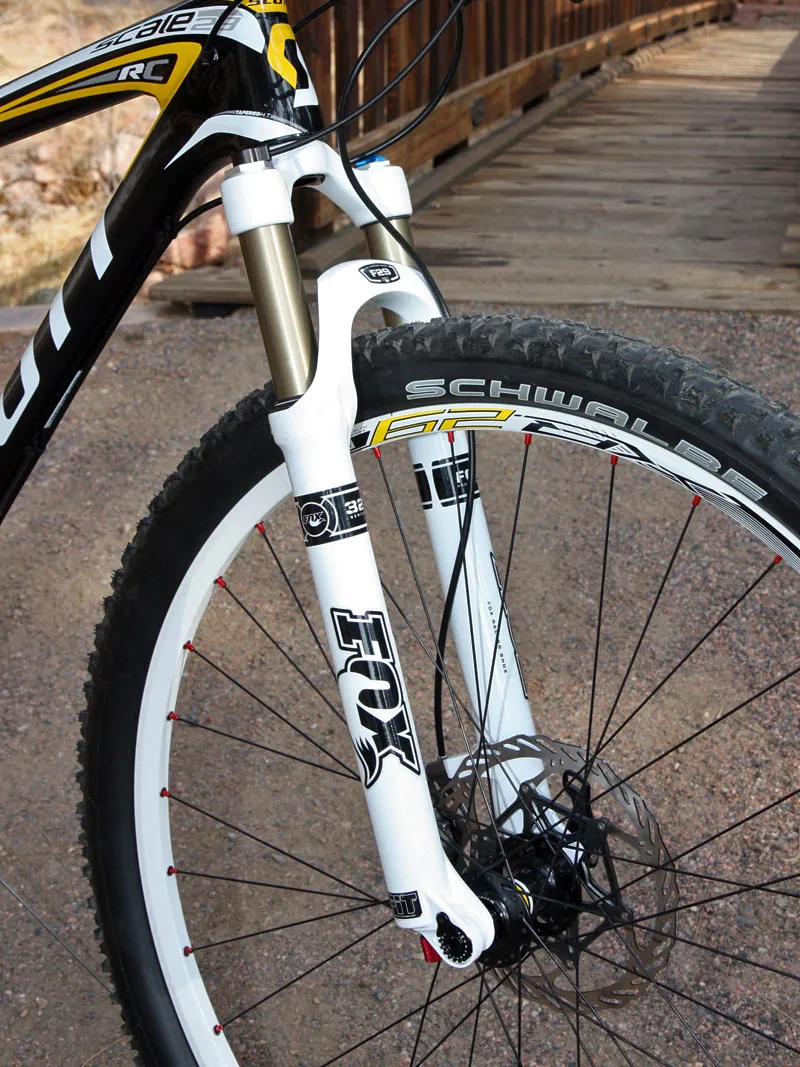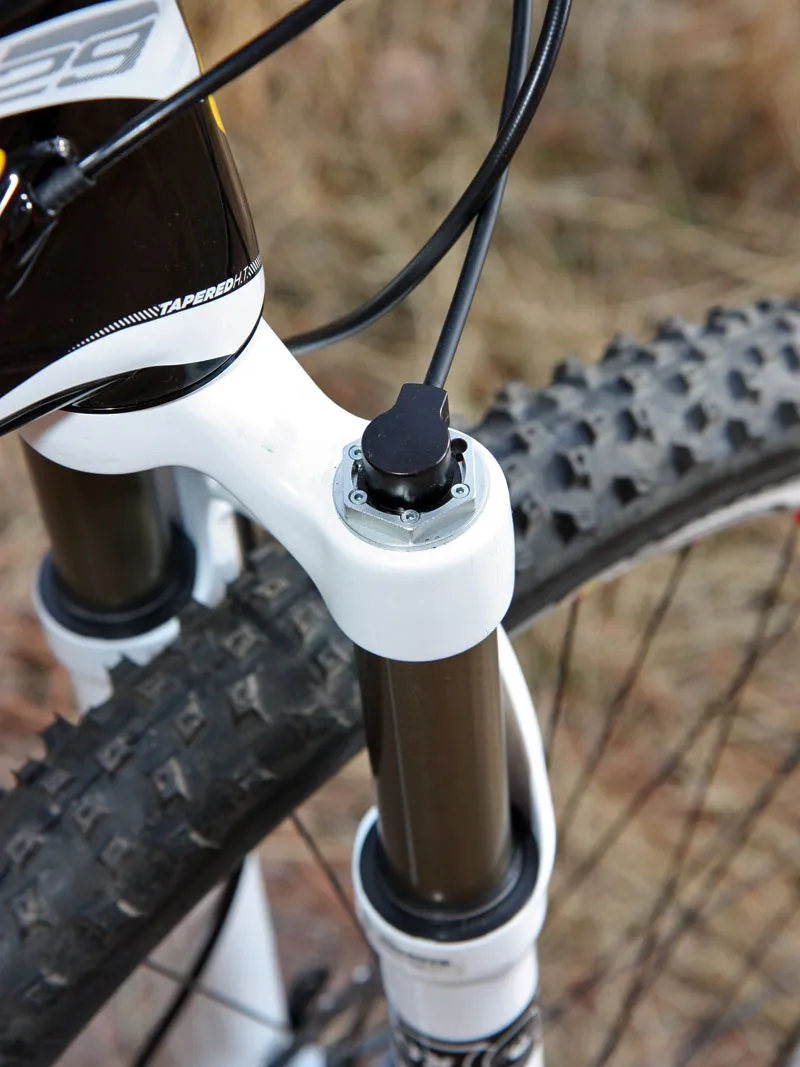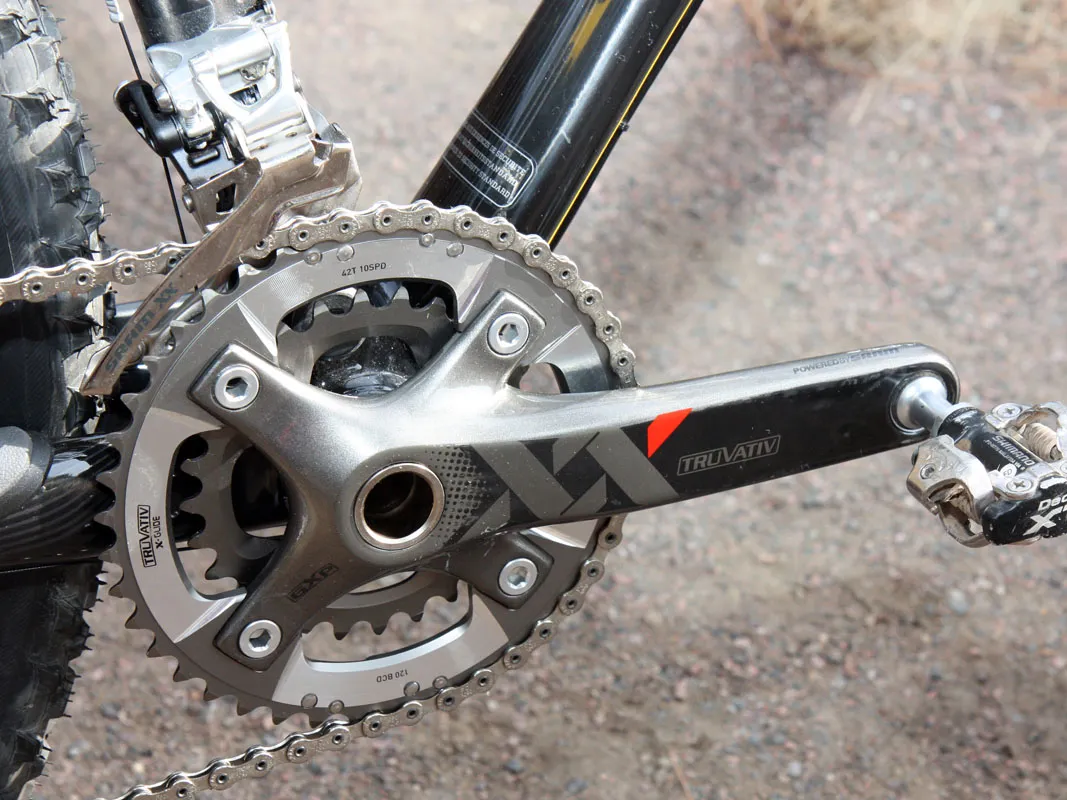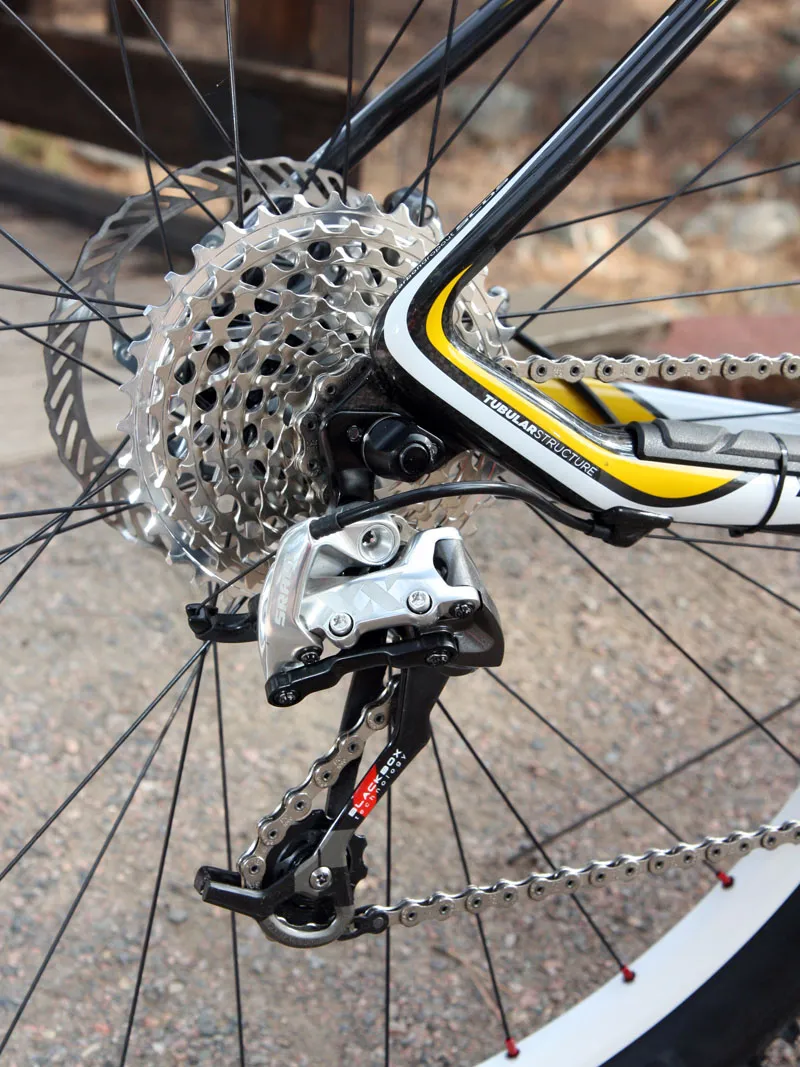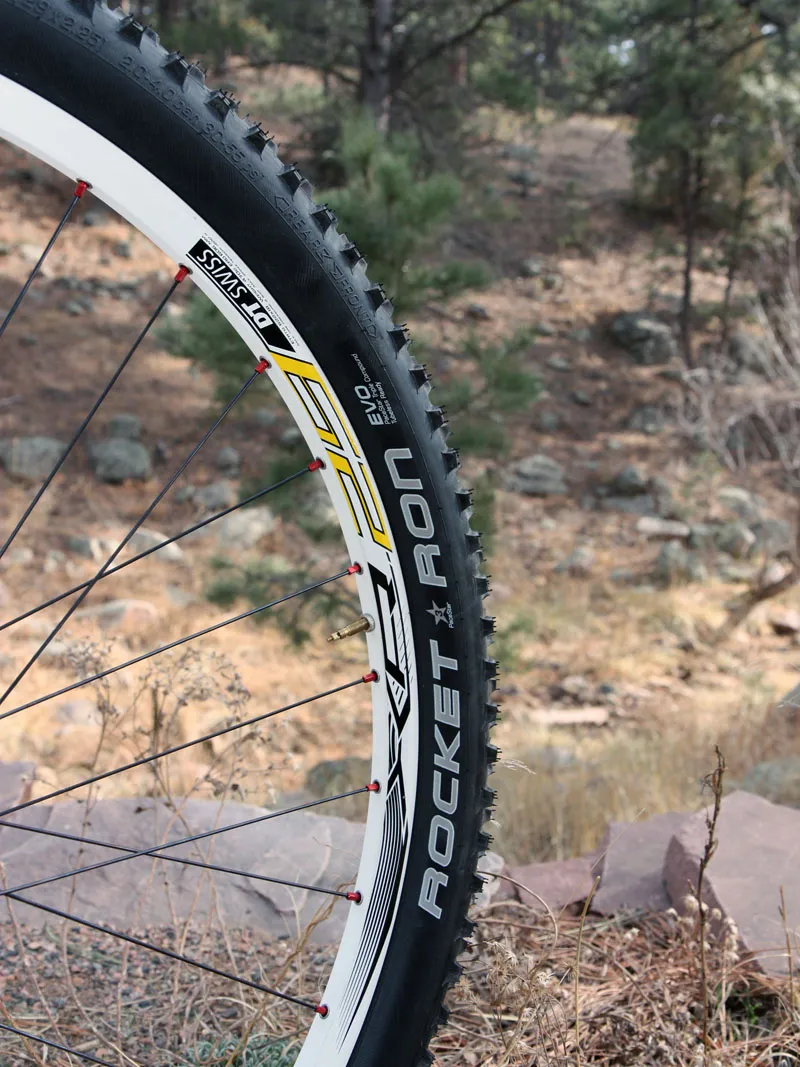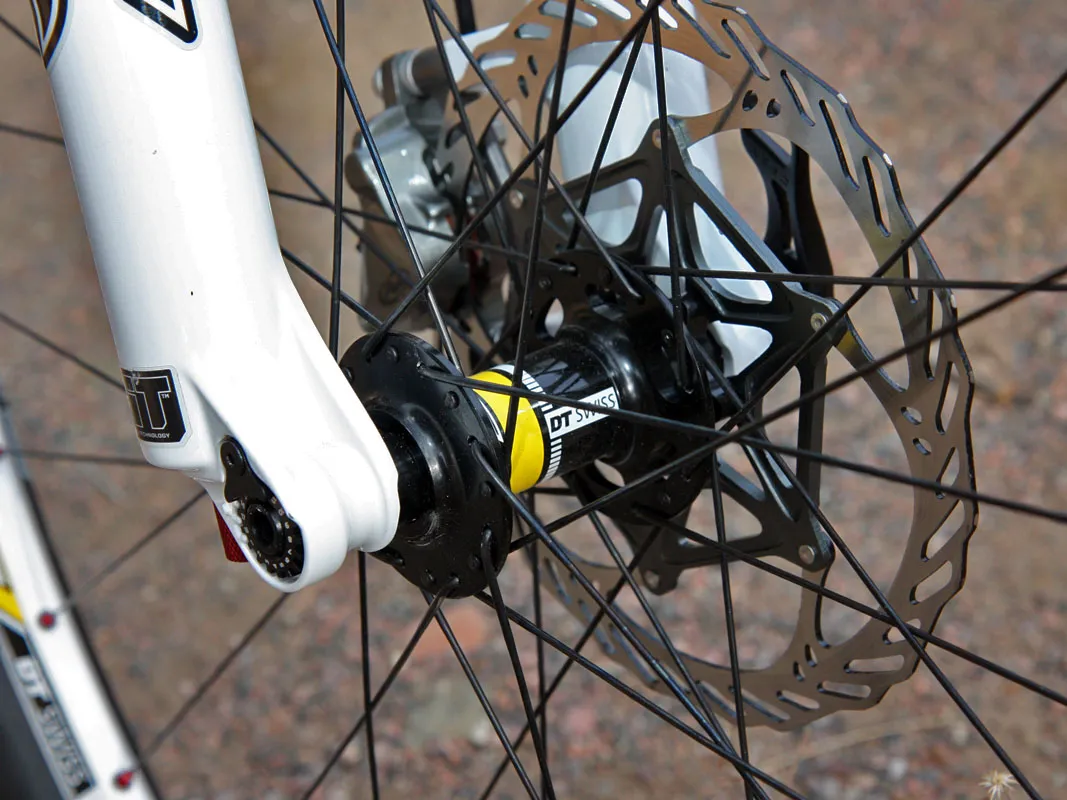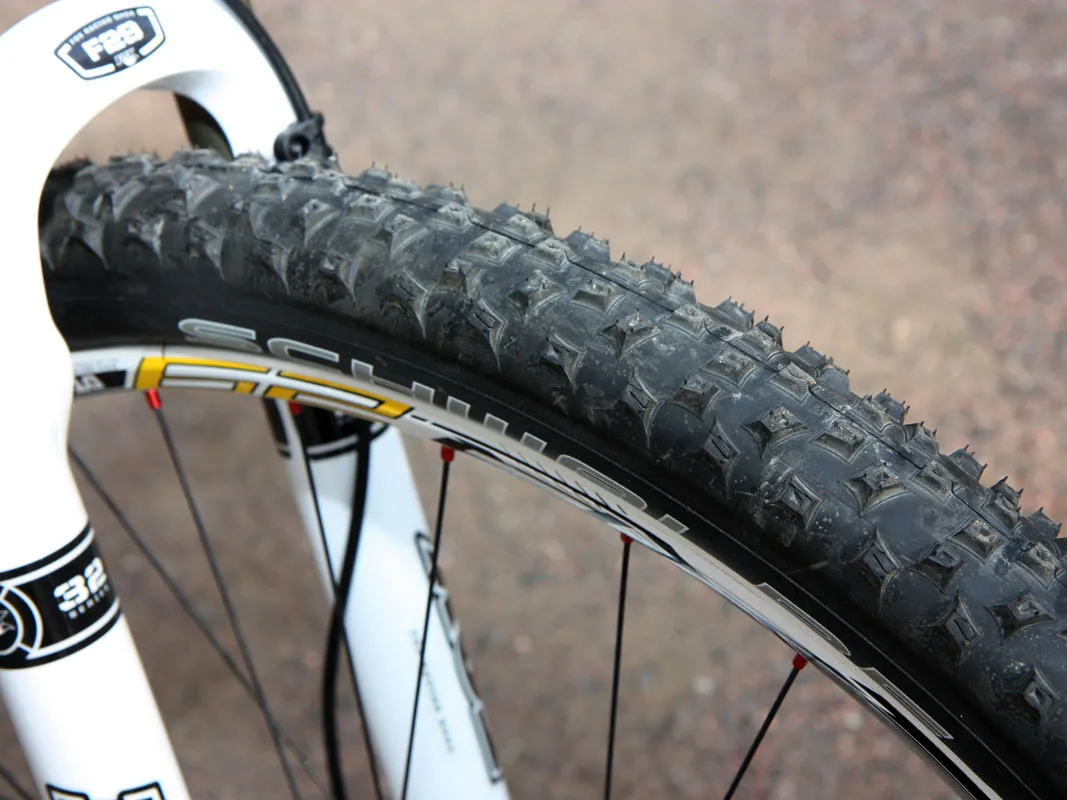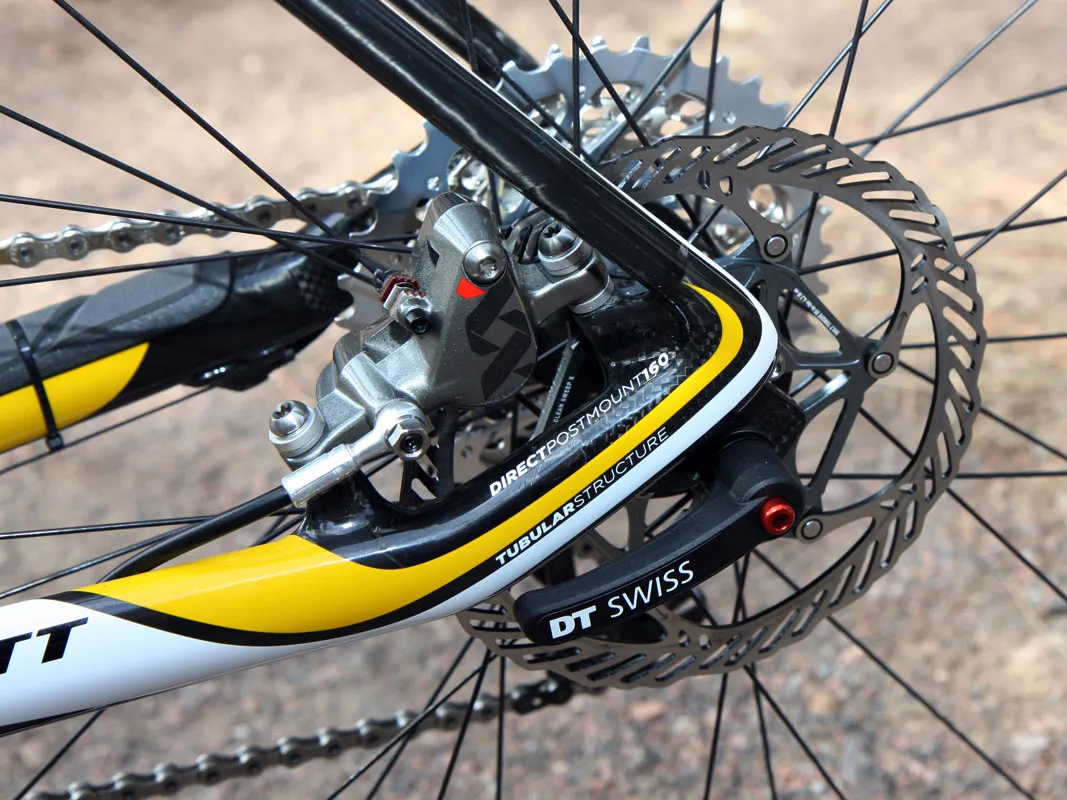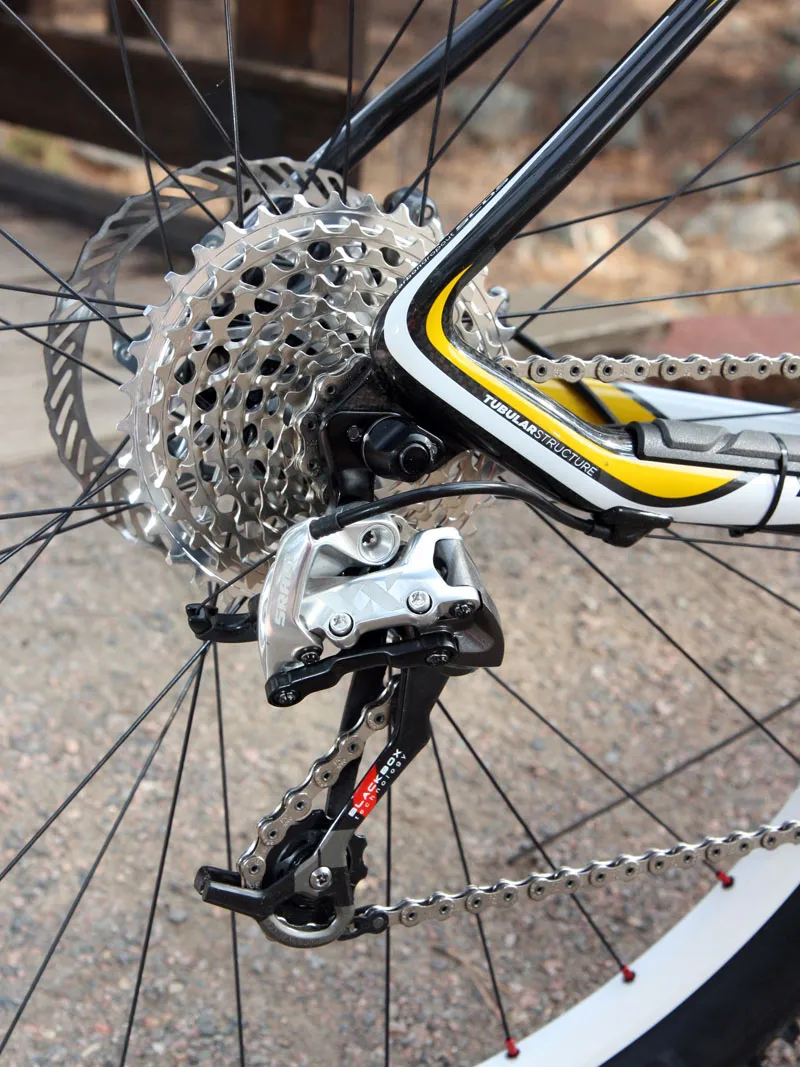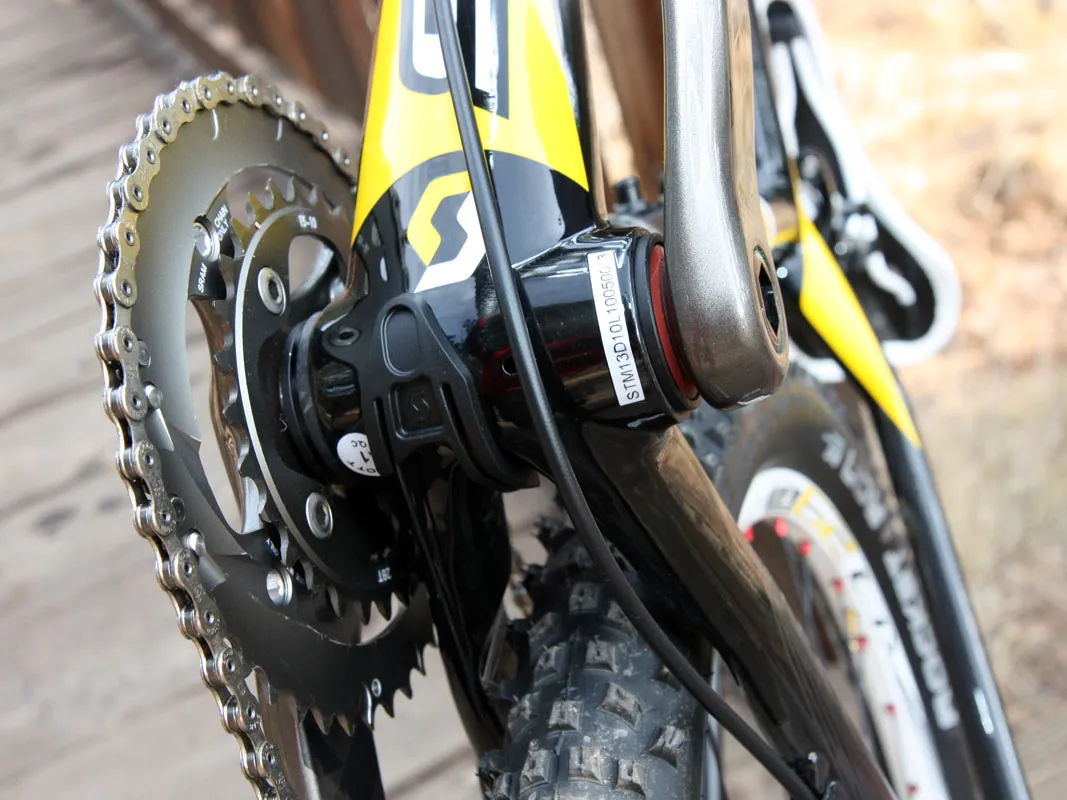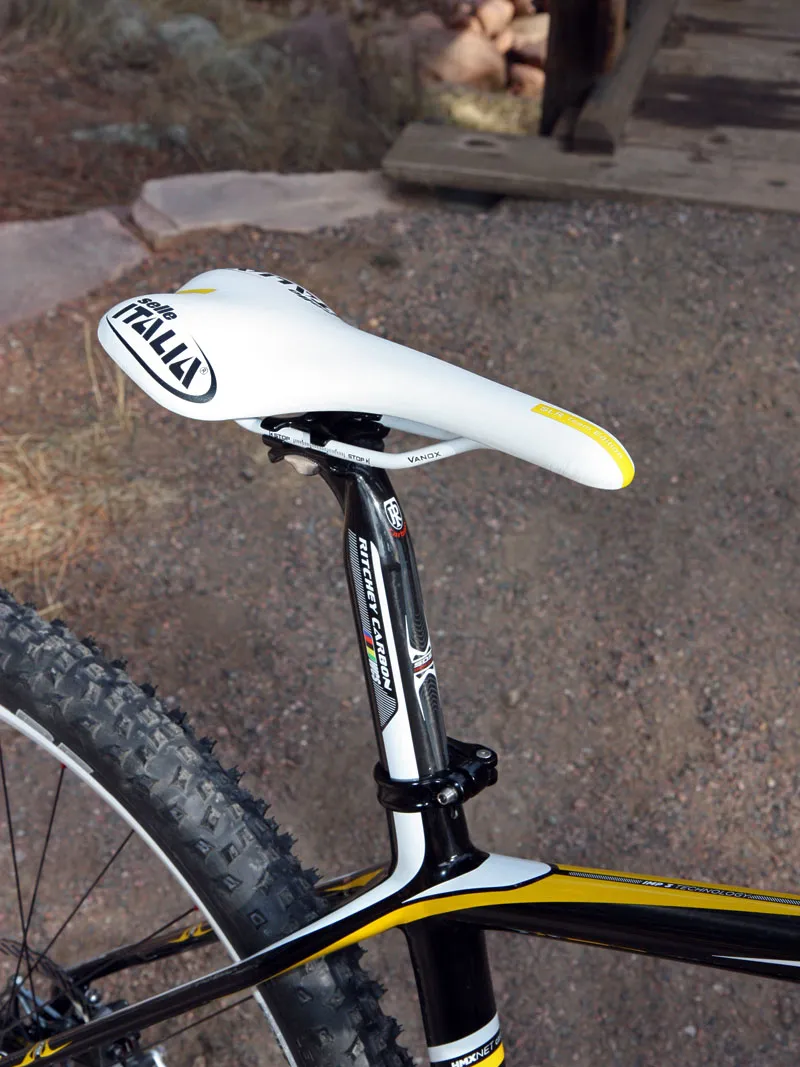With its sub-949g frame weight, Scott's Scale 29 RC carbon 29er hardtail is clearly aimed at racers, but during testing it proved itself to be an equally confident trail ride. In fact, it gave us some of the most fun we've had on any mountain bike in ages. Hey, Scott, come over here and try to take it back – we dare you!
Ride & handling: Fast and fun, with a sublime ride quality
Scott claim just 4.6mm of vertical movement is built into the back end of the Scale 29 RC but in practice it behaves like more. Coupled with the inherent vibration damping characteristics of good carbon fiber construction, that tiny bit of movement yields the smooth and sublime ride quality you'd expect on gentler terrain.
What you might not expect is the way it also mellows things out overall by rounding off the violent spikes that come with bigger trail features to which your arms and legs just can't react quickly enough. Add in the associated traction benefits and the overall 'monstertruckability' of 29in wheels shod with relatively fat tires, and the result is one of the most glued-to-the-ground feelings we've experienced on any hardtail.
Not to mention a ridiculous amount of speed – this sucker is seriously fast. It's not just a race bike, though. Over the past six weeks our test rides took the Scale 29 RC across all of our usual Colorado stomping grounds. Given the off-season timeframe of our testing, it didn't include any racing so we treated it as we would any other trail bike and this carbon wündermachine surprised us there, too.
We had perhaps our most enjoyable descent ever down the tricky front side of Hall Ranch, complete with a few little drop-offs and lots of tricky granite fields that conspire to swallow standard 26in wheels. We happily clawed our way up the annoyingly loose 'connector trail' leading from town up to Betasso Preserve, and we confidently launched off the roots coming down the Enchanted Forest section of Chimney Gulch.
We rocketed through the incessantly rock-strewn Wild Turkey slight downhill section of Heil Ranch, happily flicking our way over/through/around everything in our path and pedaling like mad, all while barely touching the brakes throughout. We even got into the habit of launching the Scale 29 RC off of whatever (moderately sized!) hits we found on the trail, relishing in the remarkably composed behavior upon landing.
Frame: Stiff yet super-light chassis provides point-and-shoot handling
Scott haven't tempered any of the usual hardtail attributes, either; in fact, the Scale 29 RC chassis ups the ante. It's wonderfully rigid everywhere it should be and yet still very entertaining in the right environment and the hands of a skilled rider. Without the filter of true suspension to water things down, reflexes are still 'right now' quick, which comes in handy at higher speeds when you need those fast reaction times – after all, you're still on a hardtail and can't just plow through things.
Tube sections are enormous in the front triangle, aided by the tapered 1-1/8 to 1-1/2in head tube/press-fit 89.5mm-wide bottom bracket combo, both of which afford more real estate for the adjoining tubes and the concurrent extra lateral and torsional stiffness that comes with them. The seat tube flares radically outwards just below the front derailleur mount and the top tube is wide and relatively thin.
The down tube is gargantuan. The chainstays are fat as well, but the seatstays are shockingly slender and flattened, much like the road-going CR1 that shares the pseudo-flex stay design philosophy. Hey, guess what – we've now ridden both machines extensively and the idea works in both arenas so it's not just marketing hype.
Not surprisingly, pedaling response is superb. Push down, rocket forward – no questions asked. Despite what the relatively slack (especially for a 29er) 69.5° head tube angle might suggest, handling is remarkably nimble and natural feeling, with no evidence of wheel flop or languishing in switchbacks. Credit here likely goes to the extra-rigid front end that loses little in translation from input to output, the short 438mm chainstays, just-right 60mm bottom bracket drop, generously wide bar and flickable 90mm stem.
The Scale 29 RC is also really light. Actual weight for the complete bike as pictured (but without pedals) is just 9.7kg (21.38lb), while the medium-sized all-carbon frame (there is no aluminum in the bottom bracket, head tube or even the internal housing stops) is just 990g including the rear derailleur hanger, bottom bracket cable guide and chunky quick-release seatpost collar – well within Scott's 949g claim.
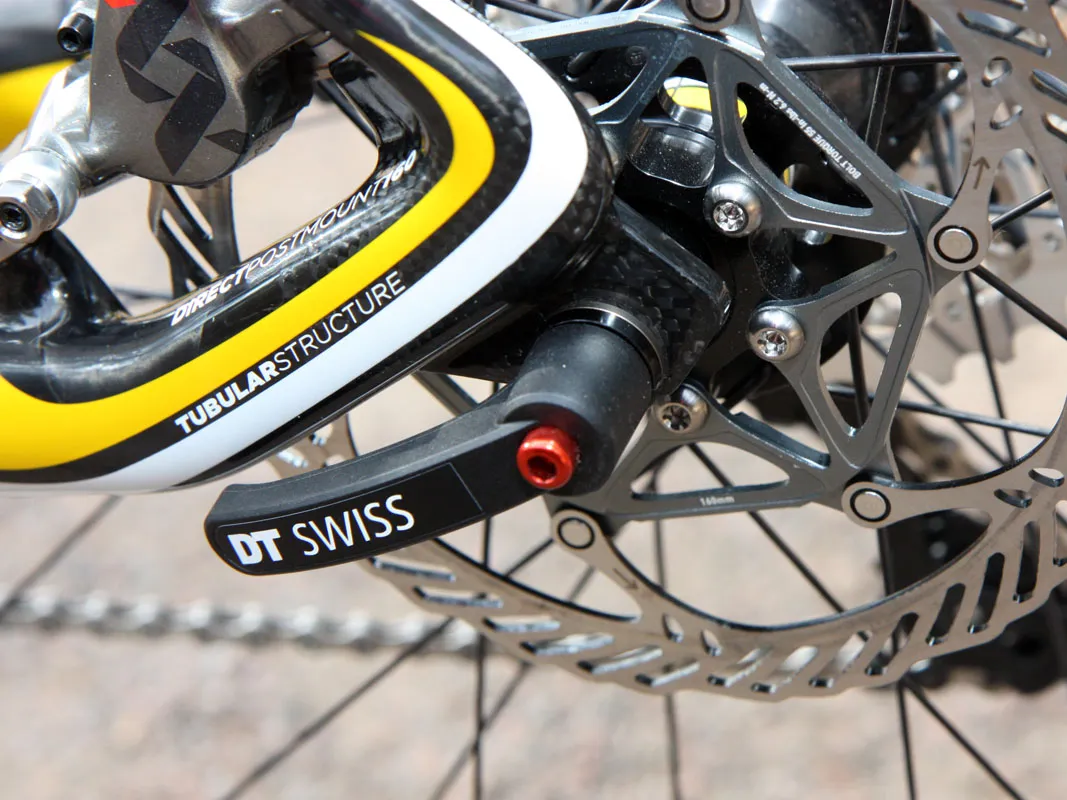
Equipment: Perfect parts pick – well, almost
When it comes to the equipment spec, Scott's product manager deserves a lot of credit. While the Scale 29 RC could easily be lighter in several areas, the company have instead opted for a balanced mix of weight savings and function, with almost no compromises in overall performance made as a result. Bolted onto the Scale 29 RC is a premium mix of parts befitting its flagship status in the company's range.
This includes custom DT Swiss alloy clincher wheels, a Fox F29 RLC fork, a mix of carbon and aluminum cockpit components from Ritchey, a lightweight Selle Italia SLR saddle, impressively fast-yet-grippy Schwalbe Rocket Ron tires and a complete SRAM XX group. Shifting was crisp and precise (especially up front thanks to the ultra-stiff chainrings and clever X-Glide tooth profiles), the drivetrain was reasonably quiet and the brakes provided ample stopping with excellent control, especially with the 185mm rotor up front.
We did have two XX-related hiccups, though: a bent rear cog during a particularly ham-fisted uphill shift (that was easily repaired, thankfully) and rear brake pistons that eventually decided they didn't want to retract fully anymore. According to Avid product manager Paul Kantor, the company have seen this before (though mostly with more heavily used brakes with worn-down pads) and current production brakes have an additional spring in the master cylinder assembly to aid in pad retraction, so hopefully this is a moot issue.
Our experience with FIT cartridge-equipped Fox forks has been mixed in recent months but the 32 F29 FIT RL 15QR bolted to the front of our Scale 29 RC was flawless. The 100mm of travel was smooth, suitably progressive and extremely well controlled, with none of the irritating stiction we've occasionally suffered before, and the handy lockout was easy to set up and effortless to use. Major kudos to Scott's product manager for selecting a 15mm through-axle fork, too.
We were initially a little disappointed with the stock wheels – they're not all that light – given the bike's hefty price tag but all things considered, they've done the job quite nicely. They come up to speed quickly enough on the trail, have held up to the aforementioned abuse with nary a quarter turn on the alloy nipples, and as always, the star ratchet rear hub internals have been faultless. However, potential buyers could shave a couple hundred grams right from the get-go by switching to some Stan's NoTubes hoops.
Scott's pick for tires, however, is spot-on. The Schwalbe Rocket Ron's open tread design grabs well on a wide range of soil types – and even bare rock – and the generous 2.25in casing provides extra float to supplement the Scale's built-in flex. The high-rebound base in the triple-compound rubber rolls with remarkable speed, and the Rocket Rons are also light at just 520g apiece (claimed). Our test wheels came with tubes but production bikes will come with rim strips pre-installed and valve stems should they decide to do the easy conversion on the tubeless-ready tires and rims – just add sealant.
The rest of the finishing kit is similarly well chosen, including the usefully wide (in cross-country racing terms) 660mm Ritchey WCS carbon flat bar, light and reasonably rigid Ritchey WCS 4-Axis 44 forged aluminum stem, and matching (very) oversized WCS carbon post. We took a bit of issue with the Selle Italia SLR Team Edition saddle, though. While it's normally one of our favorites, the stiff hull was a bit much after several hours on the trail.
As for that seatpost, our initial view was that Scott could have gotten an even cushier ride by selecting a smaller 27.2mm diameter instead of their usual 34.9mm variety. "Unlike a conventional hardtail that relies on seatpost or seatmast flex for compliance, we've engineered compliance in the SDS stays," Scott's US marketing director, Adrian Montgomery, told us. "Our Scott-Swisspower riders found they wanted compliance even while standing.
"This bike was made with direct input from Florian [Vogel] and Nino [Schurter], two of the most capable cross-country riders on the planet, and Swiss Cup winners aboard the 29er. We feel that our oversize seat tube in conjunction with the IMP process produces a superior structure than those with smaller diameter tubes. They'll last longer and they have to be stiffer than the compliant zones in order for them to function properly."
If you're vertically challenged, it's worth noting that sizing only goes down to 'medium' and it runs big, too. Scott won't confirm the addition of a small size next season but have suggested it's a possibility. Cross your fingers. Otherwise, the lone remaining issue (as always) is cost. Few riders will be willing and able to shell out well over US$6,000 for a hardtail, no matter how good it is. That being said, this is one of the best we've ridden and if you're capable of adding one to your stable, consider yourself very, very lucky.
